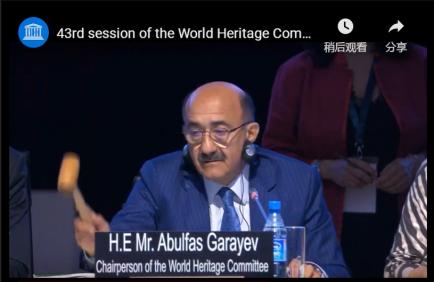
In July 2019, the bird sanctuaries in the Yancheng Yellow Sea wetlands were inscribed onto UNESCO's World Heritage List for meeting the World Natural Heritage Selection Criteria (x), and the outstanding universal value recognized by UNESCO is expressed as below:
Overview—Migratory Bird Sanctuaries along the Coast of Yellow Sea-Bohai Gulf of China (Phase I), located in the world's largest intertidal mudflat system, protects biodiversity of global significance. The serial property is an irreplaceable and indispensable hub for over 400 bird species, and critical for the over 50 million migratory birds moving along the East Asian-Australasian Flyway, which spans some 22 countries across two hemispheres from the Arctic to South-East Asia and Australasia. The global importance of the wider coastal area is further evidenced by several Ramsar sites, some of which fully or partially overlap with the property. The property is a promising beginning to identifying, conserving, and managing the most meaningful representations of a larger, globally significant, yet highly vulnerable, natural heritage system.
The site is home to 680 vertebrate species (415 birds, 26 mammals, 9 amphibians, 14 reptiles, 216 fish, and 165 benthic species) and is a coastal habitat for a large number of bird species, including the provision of molting, resting, wintering and nesting sites. The coastal mudflats of the Migratory Bird Habitat serial sites support a large number of international migratory bird species, including rare and endangered migratory bird species, and are of particular importance for the conservation of the world's migratory birds. The Phase I site in Yancheng provides important seasonal habitat for more than 10% of the migratory bird populations along the East Asia-Australasia migratory route, including two of the world's rarest migratory bird species, the Spoon-billed Sandpiper (Eurynorhynchus pygmeus) inscribed on the IUCN Red List of Critically Endangered (CR), and greenshanks (Tringa guttifer) inscribed on the list of Endangered Species (EN). At the same time, this only remaining natural habitat is crucial for the survival of other threatened species, such as the Black-faced Spoonbill, Oriental White Stork, Red-crowned Crane, and Great Sandpiper.
Integrity—The heritage site is an important part of the East Asian-Australasian Flyway. The heritage site consists of two parts (YS- 1, YS-2) with well-defined boundaries, and within the boundaries of the heritage site, there is a unique silty mudflat, which creates an intact intertidal mudflat between fresh, brackish and salty water. The Phase I nomination site and the buffer zone, with an area of more than 260,000 hectares, ensure that the ecological functions are coherent and that the intertidal ecological processes can take place without restriction. Sufficient areas, high-quality mudflats, and undisturbed natural ecosystems provide high-quality resting places and extensive space for migrating birds. The main body of the marine plains and mudflats along the coast of the heritage site was formed before 1855 when the Yellow River returned north. At present, its intertidal mudflats are still mainly in the process of siltation under the special marine hydrological conditions, and the large amount of sediment brought by the rivers, under the interaction with the ocean currents, formed the vast marine coastal plains, silty intertidal wetlands and the radial sand ridge groups, which have shaped a series of different habitat types and migratory birds' habitats.
Protection and management capacity -- The entire coastline is located in a densely populated and economically developed area, and has long been subject to very significant anthropogenic modifications and impacts. At present, the heritage sites are basically located in protected areas, wetland parks, and wetland conservation communities, and have the attributes of protected areas, which are strictly protected by national laws, and the ecological red line formulated by the State also plays an adequate role in protection, and these management and protection policies can ensure that the area maintains the integrity of the ecosystems and biological processes in a non-disturbed manner. The official Ecological Red Lines also provide adequate protection. All these can ensure that the region remains undisturbed, maintaining intact ecosystems and ecological processes.

Source: https://whc.unesco.org/en/list/1606/